Sonata Form: The Development
III. The development in general: coverage of a single development
IV. The opening of a development
VI. Recapitulatory (Expository) developments
VII. Premature and False Reprise
I. Uses of development
A. Modulation to V in exposition
B. Development section proper
C. In the second phase of the recap, the so-called secondary development
A. Fragmentation
B. Deformation
C. Use of themes or fragments in imitative contrapuntal textures
D. Transposition and arrangement in rapidly modulating sequence
III. The Development in General: coverage of a single development
Beethoven: Symphony No. 4, I: measures 185 – 336
This is a fine example of a beautifully structured and elegantly conceived development. As the chart shows, the development is in four broad sections, with subsections of both the first and last sections. My chart combines two analyses: that of A. Peter Brown, which is quite recent, and that of Percy Goetschius, which dates from the late nineteenth century. Both writers agree on the general space of the development.
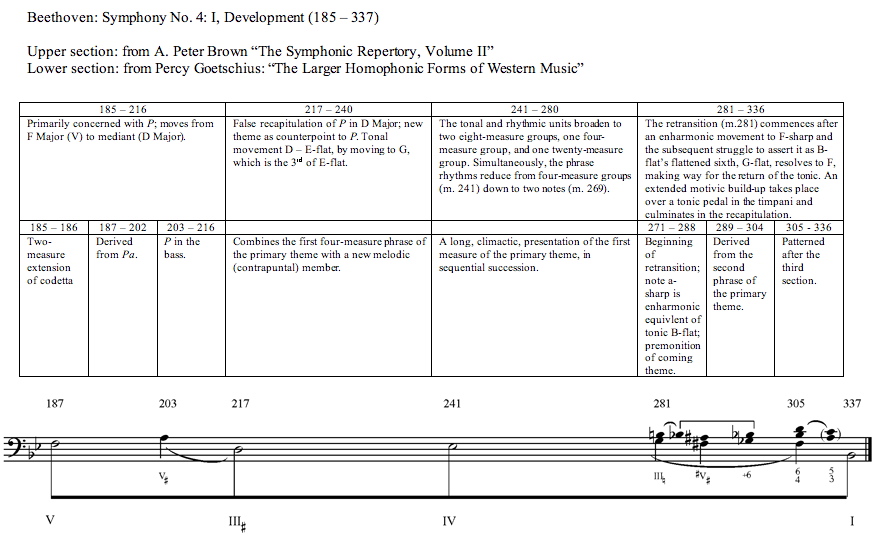
Section 1: makes a large-scale movement from F Major (the key of the dominant) to D Major, with a stop on A Major (m. 203) as a large-scale dominant to D Major.
Section 2: Set in the major mediant key of D Major, this begins with a ‘false recapitulation’ of the primary theme, and then moves on to combine the theme with a new contrapuntal member.
Section 3: Set in the subdominant key of E-flat Major, broad and climactic.
Section 4: This is the retransition, beginning with a rather enigmatic G Major (which is the submediant major triad) and then through a series of enharmonic shifts creating an augmented sixth chord in B-flat Major, which is then used to resolve to a cadential 6-4 in B-flat Major. However, the cadential 6-4 does not actually resolve, but instead gives way to a tonic triad proper at measure 337 and the beginning of the recapitulation.
IV. The Opening of a Development
A. Main theme
Most typically, especially in the middle of the century, development sections begin with the main theme, stated in the dominant. Although it really became something of a stereotype by the end of the century, it was never wholly abandoned.
1. Haydn Symphony 17 in F Major I
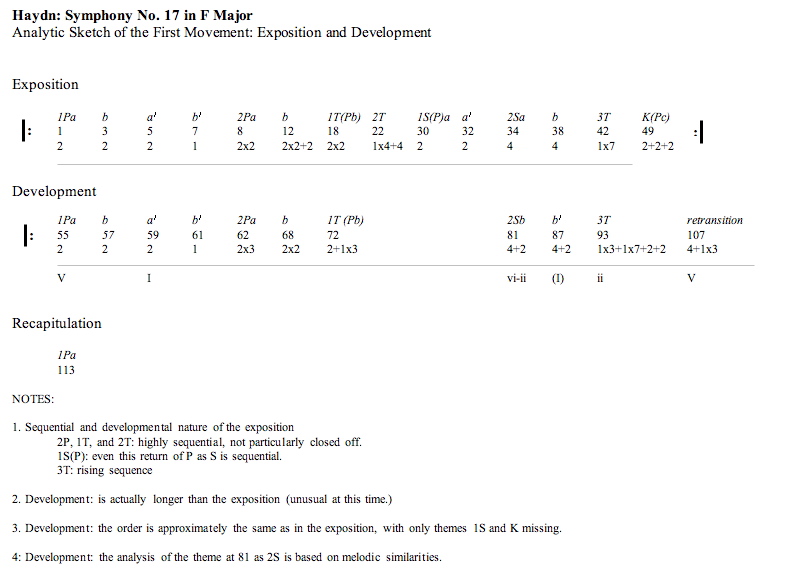
Here is just one (out of very many) example of the technique used simply, but this movement provides a splendid illustration of basic developmental techniques.
The main theme in the exposition is repeated at the opening of the development, in the dominant, then in the tonic, only beginning to change during its second phrase. It’s interesting to note that there is a monothematic nature to this first movement—i.e., the main theme reappears right at the moment of arrival to the dominant key, although it is followed by other themes.
Other issues to note are
o Extensive use of sequence in a notably Baroque manner
o Strong cadence on vi at measure 79
o Extensive retransition which eventually settles on V (106) and stays there until the recap at 113.
2. Haydn Symphony 43 in E-Flat Major “Mercury” I
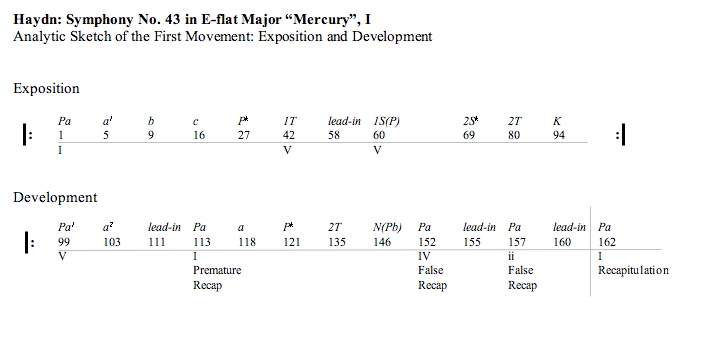
The exposition proper opens with the coup d’archet, which rather changes things for the main theme at the beginning of the development: typically if an exposition opens with such a figure, it won’t be repeated for the beginning of the development. Here Haydn manages to have his cake and eat it to, by using the second two measures of the theme. (recording opens with the main theme, three seconds of silence, and then the opening of the development.)
3. Mozart Symphony 35 in D Major “Haffner” I
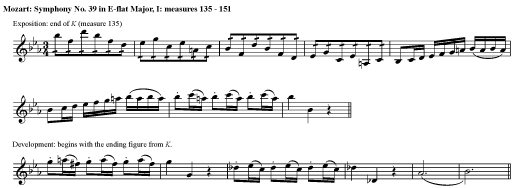
Here Mozart barely alludes to the main theme of the movement before he is moving away from it, but it’s enough to honor the tradition. (recording gives the opening theme, three seconds of silence, and then the opening of the development.)
B. New theme
This sounds kind of odd, but in fact it was not that uncommon a practice. One of the composers who tended to do this was Johann Christian Bach—although he was just as likely to begin the development section with the main theme in the dominant as well. Here's the Symphony in D Major Op 18 No 4, I:

The development opens with a new theme (that has some motivic connections to the secondary theme) in the dominant, which it then proceeds to treat in a developmental manner—almost as though it were something encountered in the exposition. (Recording: the main melody, and then 4 seconds of silence, and then the beginning of the development, as in the example.)
C. Other materials
1. Mozart: Symphony 39 in E-Flat Major: tail of the closing theme (recording is ending of exposition and beginning of the development.)

2. Mozart: Symphony 25 in G Minor: tail of the closing theme (recording is the closing theme and then the transition into the development.)

3. Mozart: Symphonies 40 and 41: short modulating figures and then restatements of an important theme in unlikely key:
4. Symphony 40 moves quickly to main theme in F-sharp minor (recording is the closing theme and the beginning of the development.)
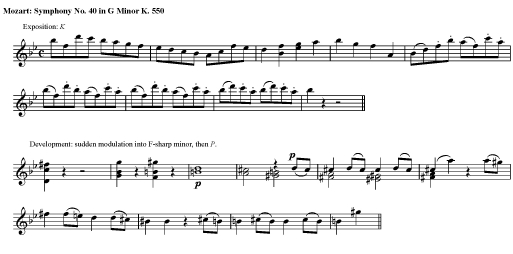
5. Symphony 41 moves to secondary theme in E-flat major (recording is the closing theme and the beginning of the development.)

A. It was quite normal to cadence on vi about 2/3 of the way through the development section.
1. Mozart Pf Sonata K. 309 I
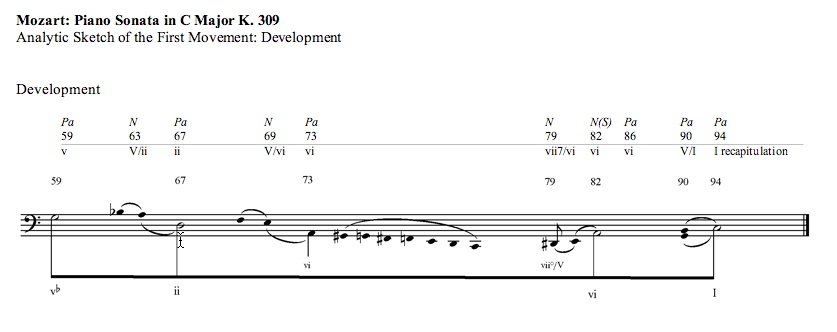
The development begins with the main theme in the dominant minor (!), and then moves to a strong, perfect authentic cadence at measure 82, staying in the key of the submediant for eighth measures, following by a quick movement by step into the tonic.
B. Composers began to look for interesting ways around this.
1. Mozart Pf Sonata K. 332 I
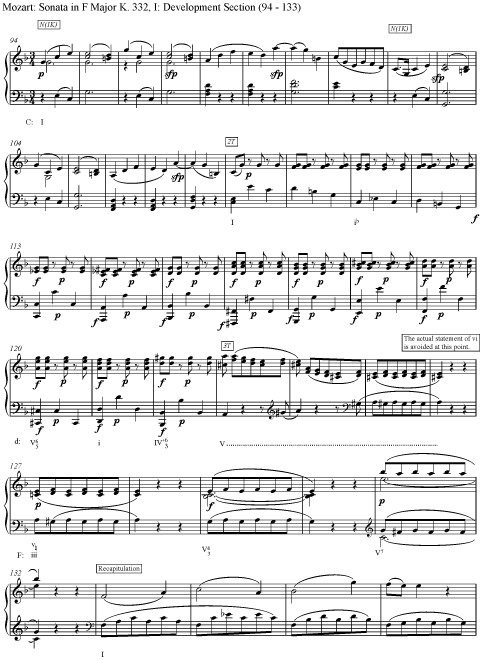
This is probably the favored technique, which is to move to V/vi instead of vi. Beginning with a passage in the dominant—almost a new theme—a sequential passage moves us to a strong V/vi at measure 123. This becomes iii (minor version of the same chord), then moves stepwise to V43 in measure 129, to V7 in measure 131.
Incidentally, this kind of ‘new theme’ at the beginning of the dominant, a theme which is really a kind of rearrangement of ideas from the exposition, is a fairly common practice.
2. Haydn Harmoniemesse of 1802 Kyrie
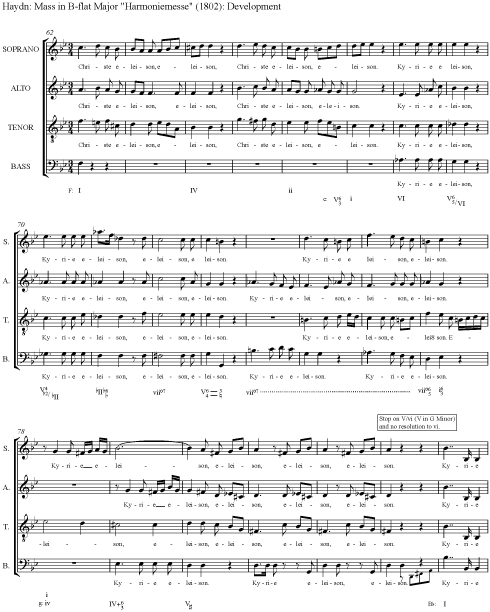
The Kyrie of this wonderful mass is in sonata form—clever enough right there. At the end of the development section there is a V/vi (D Major) triad, which moves directly to the tonic B-flat major without any intervening chords. This is a typical motion by thirds, so beloved by Haydn, and also has the interesting flirtation with cross-relations that he so loved. (Recording begins with the last bit of the exposition and moves through the development.) It’s also worth noting that this is at the very end of the development.
3. Mozart Symphony 39 in E-Flat Major K. 543
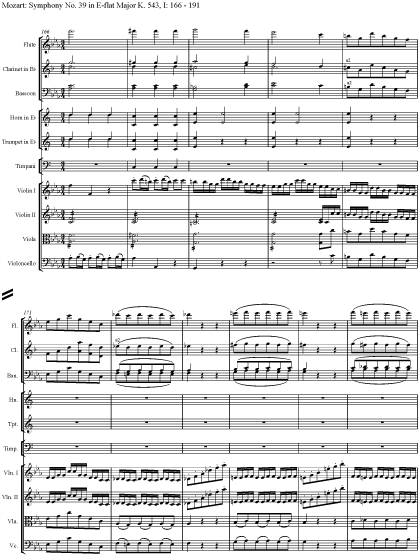
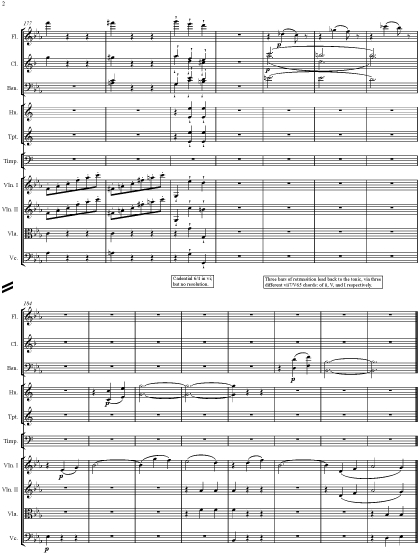
This is remarkable: at measure 179 Mozart sets up a cadential 64 into vi—but he stops and substitutes a measure of silence for the resolution, and moves onwards into the retransition without ever stating the mediant. (The recording follows the score excerpt precisely).
VI. Recapitulatory (Expository) Development
A. A development which acts like a recapitulation that doesn’t follow the key structures as one would expect in a recap, but instead works like a development key-wise including the trip to the submediant.
B. In a recapitulatory development, the development has a tendency to follow recapitulatory practices—for example, it may not begin precisely with the beginning of the exposition’s primary group, it may display a secondary development right in the place where one would expect it in the recapitulation, and so forth. However, it will avoid the closing thematic group since we aren’t closing, and will generally move into the retransition right at the point at which we expect the closing thematic group to begin.
C. Haydn Symphony No. 82 in C Major “L’Ours”
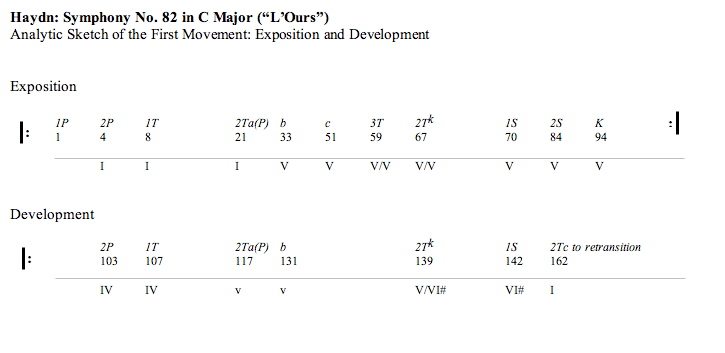
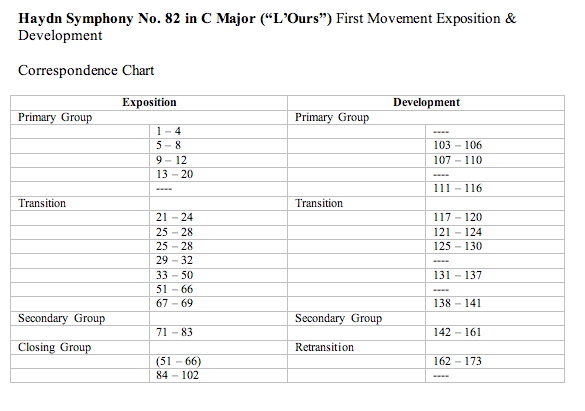
VII. Premature and False Reprise
A. Definitions
1. Premature: a ‘recap’ which comes too soon, which may or may not be in the tonic key.
2. False: a ‘recap’ which really is intended to fool the listener, or at least to surprise the listener, although it’s true enough that after a fairly short while it’s unlikely that anybody was going to be all that surprised. It became quite a common occurrence, and composers had a lot of fun working with it in novel ways. The point of the false recap is not only surprise and interest, but also harmonic: it produces a brief moment of consonance in the most dissonant section of the work.
B. Haydn: Symphony 43 in E-Flat Major “Mercury” I

1. Premature recap at 113—the entire first phrase in the tonic. We only know that it’s premature because it’s much too soon.
2. 152: after an extended sequential and developmental passage, and a cadence into the submediant, Haydn veers off and gives us a false recap in the subdominant.
3. 157: now he does another one, this time in f minor.
4. 162: the ‘real’ recap, which for a while there you aren’t even quite sure if it’s the recap or not!
C. Haydn: Symphony 55 “Schoolmaster” in E-Flat Major
This one is something of an extreme case, but brilliantly executed.
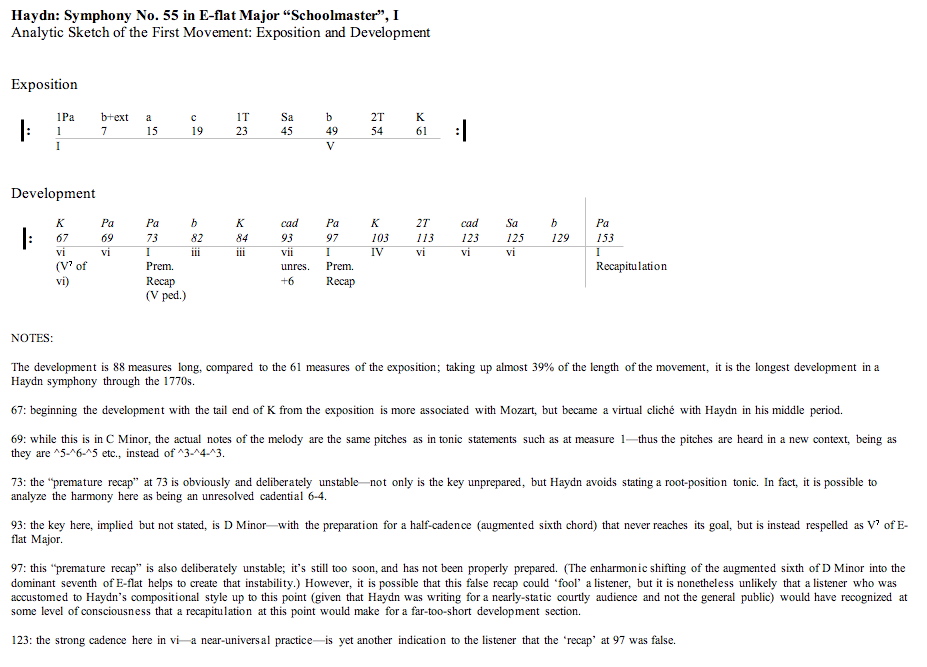
1. 67: the development opens with the tail of the exposition.
2. 69: the main theme comes in—with the same notes, but because the key context has changed from E-flat major to C minor, the notes are now in a different context.
3. 73: premature reprise, but it’s over by 78 when there’s a sudden apparent feint into the subdominant (which never occurs because the D-flat that would introduce the subdominant becomes enharmonically a C-sharp, creating an augmented sixth chord with resolves to V/iii at measure 84.)
4. 97: false reprise, really quite convincing (it’s been long enough, and it’s in the correct key) but at 103 we suddenly begin moving in a way that might arouse some suspicions that we aren’t really back at all.
5. 123: the strong cadence on vi that we would expect
6. 151: the recapitulation proper.